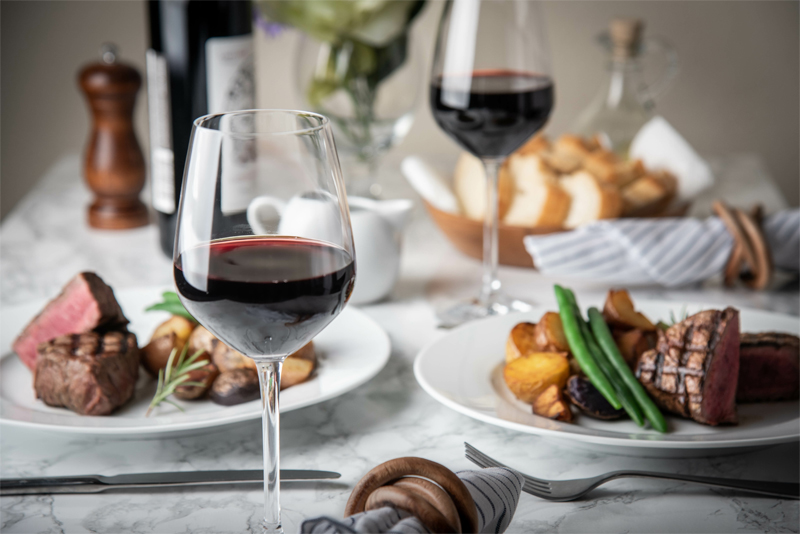
Who doesn’t like to have fancy drinks on the one hand and great food on the other? It’s just divine, especially when you’re with a special someone in your life. However, you cannot just have any glass of wine with any food on your plate. You have to pair them for a great food experience.
Extraordinary Meal Experience
When you’re dining out or having dinner at home and there’s something to celebrate, a glass of wine would be lovely to have. However, one wrong move with the pairings can spoil your food experience. That’s why it’s crucial to plan your wine choice and food selection correctly, to allow an extraordinary culinary experience.
The thing about wine and food pairings is that their goal should be harmonious and, as a gustatory team, one won’t dominate the other. The wine should have its respective distinct taste without affecting the taste of the meal’s ingredients. When you’ve found the right balance, mealtimes will be marvelous.
If you’re planning to experiment on which wine type would work best with your planned meal, consider buying wine online to have an idea of their origins. Most online wine stores list the taste notes for each bottle, along with the wine-making region where it originated and the length of time the batch was made. These elements matter because you’ll understand better what each bottle would offer regarding taste and texture. If you know these elements, it would be easier to pair each bottle with specific food items.
In addition to knowing the notes, you can see reviews from actual customers who bought bottles online. Some stores even suggest food pairings that go well with their bottles.
Increases the Restaurant’s Sales
When a restaurant has established the perfect balance of food and wine pairing, customers will enjoy dining at the restaurant a lot more as they helped make their customer’s meal experience memorable. Who doesn’t like a glass of good wine and good food?
When customers enjoy their excellent food and wine pairing meal experience, they’d be happier and would be willing to pay a lot more to maximize the experience a lot better. There would be a higher chance that customers would return to the establishment or recommend it to friends and family. It’s one instance when a winning wine and food pairing will help drive up the restaurant’s sales.
Creating the Perfect Balance
As you’re already aware of the benefits that good wine and food pairing brings to the table, you might be eager to know how to create the perfect pair. While there are many food and wine pairing examples available online, nothing beats being able to experiment and play with the flavors on your own.
Listed below are some tips on how you could create your perfect wine and food pair at home:
-
Consider the Body of the Wine
Before considering any flavor factors of the wine, you should first consider the body of the wine. The body refers to the weight or thickness of the wine and how it feels inside the mouth. There are two kinds of wine body: Light-bodied and full-bodied wines. A light-bodied wine generally feels like water in your mouth. On the contrary, a full-bodied wine can feel more like heavy cream.
When it comes to pairing, try to match complementary features. Light-bodied wine would go well with lighter dishes, such as delicate fish recipes. On the other hand, a full-bodied wine goes well with a heartier meal featuring tougher meat, such as a hearty steak.
-
Contemplate on the Tannins
Tannins are mostly found on grape skins, stems, seeds, and even the wood barrels used during the aging process. For most cases, tannins are present on red wines as a portion of grape skin is left during the wine-making process. Tannins can also be present in white wines that have been oak-aged.
Tannins taste dry and bitter and give out a particular effect when paired with food. Since salty foods bring out the bitter taste more, tannic wines are best prepared with low-salt and high-fat meals, such as a slice of well-marbled meat, to create a palatable balance.
-
Sweetness Matters
Novice wine drinkers often prefer to have their wines sweet so they could adjust to the richer flavors gradually. Some wines also have varying stages of sweetness, hence the presence of sweet wines and semi-sweet variants. Generally, wines become sweet when the sugar in grapes didn’t turn into alcohol.
The general rule of thumb when drinking sweet wine is to pair them with lesser sweet foods so as not to compete flavor-wise. One way to utilize sweet or semi-sweet wine is to pair it with salty or spicy foods. The tandem creates a contrasting blend that offers a playful taste to the mouth of new wine drinkers.
-
The Effect of Alcohol
The alcohol content of wine affects the taste of food. Thus, it may not be the best idea to pair high-alcohol variants with cream-based, super spicy, or very salty foods as alcohol tends to intensify these flavors. The combination could induce extreme and uncomfortable reactions, too.
Thus, it’s recommended to pair high-alcohol wine with high-fat dishes to even out the effect. It’s the reason why dishes with beef or pork often go hand in hand, as the fat found in these meat cuts can minimize the alcohol’s intensity.
Conclusion
Creating a satisfying balance of food and wine might sound trivial at first, but having a harmonious blend of what you’re eating and what you’re drinking maximizes the overall dining experience. Unlike other beverages, not all wines go well with just any food item, as they have particular characteristics that would either enhance or conflict with some dishes. Thus, learning which variant goes hand in hand with certain food items would best produce the perfect pair.
Comments
comments